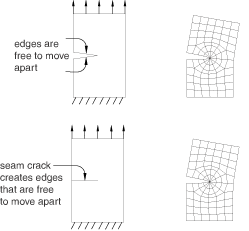Performing a contour integral analysis | ||
| ||
You can compute contour integrals for two- or three-dimensional models, and you can choose to perform one of the following types of contour integral calculations:
-
J-integral
-
-integral (for creep)
-
T-stress (for linear materials)
-
Stress intensity factors for linear homogeneous materials and for interfacial cracks lying on the interface between two linear homogeneous materials
For more information, see Contour integral evaluation.
You define cracks in the Interaction module. To perform a contour integral analysis, you must select the crack front, the crack tip or crack line, and the crack extension direction, as described in the following sections. The entities that you can select depend on whether the part is two- or three-dimensional and whether you are defining the part using geometry or using elements and nodes from an orphan mesh. In some cases the crack tip or the crack line is the same as the crack front that you selected, and Abaqus/CAE selects the crack tip or crack line for you.
A crack in a two-dimensional model is a region containing edges that are free to move apart. A crack in a three-dimensional model is a region containing faces that are free to move apart. The simplest approach to performing a contour integral analysis uses a region that already contains edges or faces that are free to move apart as the crack separates. Alternatively, you can model the crack as a line embedded in a face in a two-dimensional model or as a face embedded in a cell in a three-dimensional model. The embedded line or face is called a seam, and you can perform a contour integral analysis using a seam. When you mesh the model, Abaqus/CAE creates duplicate overlapping nodes on the seam; these coincident nodes are free to move apart as the seam separates. Seams are described in more detail in What is a seam?. Figure 1 shows a two-dimensional model with existing edges that are free to move apart and a similar model with an embedded seam that is free to move apart.

You can specify that the crack front is defined on a symmetry plane, in which case you need to model only half of the structure. Abaqus doubles the values calculated by the contour integral to arrive at the correct values. In most cases you need a refined mesh surrounding the crack. After you create a crack, you must use the History Output Request editor to request that Abaqus write contour integral information to the output database. For more information, see Contour integral output.
For detailed instructions, see Creating a contour integral crack.